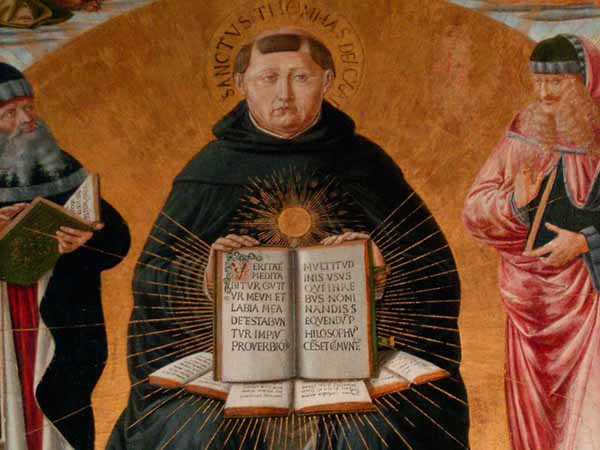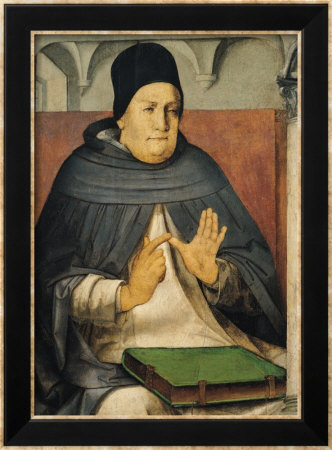Last updated on August 15, 2013
No explication of Christian History would ignore the positive/negative influence of Thomas Aquinas on Christianity in general. Known as the ultimate scholastic, Aquinas was one of the most influential because he fused philosophy and theology together. The great debate of the time centered around the rediscovery of Aristotle’s philosophy – was it opposed, compatible, or both? Aquinas took the third path. Philosophy, for him, could be a great help to the pursuit of theology.
Think of it in this way: philosophy was the reason of humankind, while theology was that of God. God did not use revelation to destroy human reason, but to add to it in order to perfect it. In this way, revelation destroys false theology and aids correct philosophy at the same time. To aid this end, Aquinas wrote the unbelievably large systematic explication of Christian doctrine known as The Sum of Theology, or the Summa Theologica in the more common Latin form. A series of books more than two million words long. Its goal was the restatement of Augustine’s theology in Aristotlean, rather than Neo-Platonic, terms.
For the sake of your own lifespan, and the safety of my readers, et us just point out his major contributions. First, Thomas teaches about the technique of analogy. When we speak of God – say, “God is good” – is what we say about God univocal with the actual sense. In other words, do they mean the same thing they do in everyday language? Or, are they equivocal, that the words mean something completely different from what they usually do, holy words? In neither case would that work; we either have too much ability to describe God, or too little ability to know him, as Romans 1 infers:
18 For the wrath of God is revealed from heaven against all ungodliness and unrighteousness of men who suppress the truth in unrighteousness, 19 because that which is known about God is evident within them; for God made it evident to them. 20 For since the creation of the world His invisible attributes, His eternal power and divine nature, have been clearly seen, being understood through what has been made, so that they are without excuse. 21 For even though they knew God, they did not honor Him as God or give thanks, but they became futile in their speculations, and their foolish heart was darkened. 22 Professing to be wise, they became fools, 23 and exchanged the glory of the incorruptible God for an image in the form of corruptible man and of birds and four-footed animals and crawling creatures.
While this might sound a bizarre distinction, keep in mind that this question does beg for an answer of some sort. What does it mean to “know” God? How much do we know of God? Do we know only what we need to know, or do we know more as Christians than we do as unbelievers? This creates quite the confusion about words! Does comprehending mean the same thing as understanding, as per the Trinity concept? Thomas Aquinas sought genuine answers, and he certainly got them.
Thus, Thomas distinguishes two types of statements, some being metaphorical (my rock), and some being in between a univocal and equivocal sense. (good) In other words, it is a true statement derived from human experience, but we can describe God – just not well. It is imperfect, in that our conception is derived from God in the first, place, so of course we can say he is good – we just can’t understand the full depth of that idea. This makes a great deal of sense in explicating language about God without giving human beings overbearing descriptive power of God. It also takes describing God out of the realm of subjective experience into objectivity, a commonly held ideal for all.
However, his other big contribution brings my own Protestant senses tingling, in that he rigorously established the thoroughly Catholic idea of transubstantiation. Most churches don’t even bother doing communion, Eucharist, what have you anymore, solely because the important and symbolism of sharing the Lord’s table seems lost on our generation. It was set in Christian theology among the sacraments regardless of one’s interpretation and denomination, and it’s honestly sad to see it dissipate so thoroughly now as overwrought symbolism or tradition (a distinctly American rejection, now that I think about it, that falls in line with secular culture).
Regardless, let’s look a little closer at this concept of transubstantiation. The Eucharist, as you may or may not know, is a tradition established by Jesus’ words in the Last Supper to partake of Jesus’ body and blood in the form of bread and wine. There’s certainly other references, but let’s look at Matthew 26 just as an example:
26 While they were eating, Jesus took some bread, and after a blessing, He broke it and gave it to the disciples, and said, “Take, eat; this is My body.” 27 And when He had taken a cup and given thanks, He gave it to them, saying,“Drink from it, all of you; 28 for this is My blood of the covenant, which is poured out for many for forgiveness of sins.29 But I say to you, I will not drink of this fruit of the vine from now on until that day when I drink it new with you in My Father’s kingdom.”
People for generations debated the actual nature of what happened here, but as Jesus commands His disciples, and as we new Christians also exist in a process of discipleship, so too do we take the body and blood. The issue, then, is what exactly happens when we do this. Did Jesus mean this in a symbolic sense? Did He mean this in the literal, spiritual sense that you actually eat His body and His blood? Frankly, the terms of the Eucharist/communion weren’t well-established. The early Church had many different opinions on this issues. Knowing that the scholastics sought to explain most everything, imagine how the Eucharist fit into their theology.
Hoo boy.
If, in the Eucharist, the substance of Christ’s blood and body are present, what happens to the substance of bread and wine? Remember that in Aristotle, things aren’t necessarily what they are by virtue of ideas. Most “things” exist as both real substance and physical appearance, and these may align or may not. Does the presence of Jesus replace it? Is this merely a symbol of remembrance and nothing changes? These were important questions, for they determined the meaning of the sacrament.
People provided many different alternative modes of thought. Consubstantiation, annihilation, and conversion were the three alternatives. Consubstantiation states that the bread and wine exist concurrently with the body and blood; this is mostly known as a Lutheran development now, though it certainly existed long before that. Annihilation means that the body and blood literally destroy the original substance of the bread and wine; you literally eat body and blood. The last, conversion, comes across as something rather strange; when the priest performs the sacrament, the bread and win literally transform into the body and blood of Christ – i.e., they’re “converted”.
Here, Aquinas runs into a problem. How does this happen? Taking cue from an earlier council that stated that they retained the same appearance as their previous forms, he distinguished between the “substance” and “accidents” of the objects. Changing aspects are the accidents, while the essential components are the substance of the thing. Thus, in transubstantiation the accidents of bread and wine stay the same, but have their substance wholly changed to body and blood (read further quote). It also doesn’t mean Christ is stuck “in there”, but his presence is still all around, omnipresent. Or, as Aquinas says:
Now according to this mode of hus being under the sacrament, Christ is not moved locally in any strict sense, but only after a fashion. Christ is not in this sacrament as if he were in a place, as we have already said; and what is not in a place is not moved locally, but is only said to be moved when that in which it is is moved.
Yes, completely clarifying. Of course, you still can’t see it or anything. And the only proof that this happens, is no proof. And it doesn’t say it in the Bible anywhere I can find, unless you take that last supper thing a bit too literally (Augustine warned us against this). But hey, it was scholasticism. The point wasn’t that we had an in-depth understanding of everything, but that our rational, logical impulses came from God, and that we could use them to understand Christianity as well.
In writing about John Scotus Eruigena, I said that such explications do help the Church. Thomas Aquinas, on the other hand, left a bevy of material without a great lens by which to interpret it. He wasn’t popular in his own time, and much of his work came under condemnation from the Church for some time after his death. His case represents the flip side of the scholastic coin.
One might ask, what is the purpose of scholastic explication? To use philosophy as a tool in tandem with theology. Though God’s Word was still the primary source, philosophy began its ascendancy in Christian thought. But can one find a doctrine of the Eucharist in the Bible, or of transubstantiation? They are, in their own way, constructs of the philosophical worldview. These are problems, only in the sense that the paradigm that allowed this thought also forced answers to questions that, earlier, were not even to be explicated.
Take, for example, the common pejorative against scholastics: how many angels can dance on the point of a needle? While these might be interesting intellectual exercises that give a different way of thought, what relevance do they have for the ordinary believer? Even Augustine’s work have a pastoral sense in them, but the speculative nature of these inquiries certainly remains an academic exercise. Rather, Thomas Aquinas represents the zenith of the conflation between facts and faith – his tortured explications of, say, whether hair or nails will grow after the Resurrection, are an issue of philosophy rather than faith. Or, perhaps, a bit of insanity.
I do not judge the man, but his ideas, and while they may aid us in the academic sense, they do not exist to help the believer further his walk. That is a bit of a shame!


